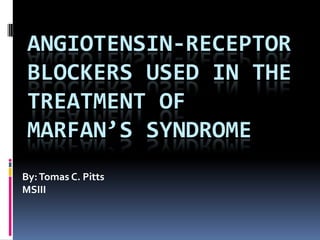
Angiotensin Receptor Blockers Used In The Treatment Of Marfan’S
- 1. ANGIOTENSIN-RECEPTOR BLOCKERS USED IN THE TREATMENT OF MARFAN’S SYNDROME By: Tomas C. Pitts MSIII
- 2. What is Marfan’s Again? Marfan’s syndrome is a disorder of the body's connective tissue that can affect the skeletal system, blood vessels, heart, lungs, eyes and other organ systems.
- 3. Who gets Marfan’s and how? Marfan syndrome can be inherited from either parent, or it can result from a new change in genetic material. If a parent has Marfan syndrome, offspring have a 50-50 chance of inheriting the disorder. Approximately 200,000 people in the United States have Marfan syndrome, which can occur in men or women of any race or ethnic group. Many affected individuals are young adults, adolescents or children.
- 5. Common Complications of Marfan’s Syndrome. Aortic Insufficiency – Diastolic decrescendo murmur @ the upper L. sternal border. (Aortic dilation, Aortic regurgitation, Aortic aneurysm). Aortic dissection – Tearing pain radiating to the back, asymmetrical upper ext. pulses. Mitral Valve Prolapse – Midsystolic “click” w/ late systolic murmur.
- 6. Traditional Marfan’s Tx. Beta Blocker (Atenolol/Propanolol) ACE Inhibitor (Lisinopril) Calcium Channel Blocker (Verapamil) We are now starting to realize the potential of the ARB’s in Marfan’s Sx. (Ex: Losartan)
- 7. Trial A control group consisted of 65 children with Marfan’s syndrome who were not treated with an ARB. The median age of the patients was 6.5 years, and half of them were boys. The mean aortic root diameter before ARB therapy was 3.7 cm, and the median duration of treatment was 49 months. No changes in heart rate or blood pressure occurred after initiation of the ARB. The mean rate of aortic root enlargement before treatment was 3.54 mm per year; after therapy was started, the mean rate was 0.46 mm per year (P<0.001). The more distal sections of the aorta, usually unaffected by Marfan syndrome, continued to show an age-appropriate growth rate. In the control patients who received beta-blockers but not ARBs, the mean rate of change was 1.71 mm per year.
- 8. Why Does The ARB Slow Dilation of the Aortic Root? Not entirely sure Inhibition of excessive TGF-β signaling (due to fibrillin-1 mutation) and subsequent inhibiton of matrix metalloproteases (notably MMP’s 2 & 3). This reduces extracellular matrix deterioration and thus, aortic dilation
- 9. Matrix Metalloproteinases Implicated in tumor invasion Remodels insoluble components of basement membrane. Releases ECM-sequestered growth factors. Has chemotactic, angiogenic, and growth promoting effects (ex. MMP9 – cleaves collagen of epithelial and vascular basement membrane and stimulates VEGF from ECM sequestered pools.
- 10. Matrix Metalloproteinases cont. The body’s stores of metalloproteinase inhibitors are greatly reduced during these insults and greatly shifts the balance in favor of tissue degradation. Exogenous MMP inhibitors have had poor results because the body can switch between using MMPs and Ameboid migration which allows cells to use collagen IV as a “highspeed railway” to navigate the matrix and attack/invade the target tissue.
- 11. Transforming Growth Factor β Loss of microfibrils give rise to abnormal and excessive TGF- β. Excessive TGF- β has deleterious effects on vascular smooth muscle development and the integrity of the extracellular matrix. In mice models TGF- β antibodies helps to prevent this damage and similar human studies seem to be promising (Robbins, Pathologic basis of disease, pg. 145)
- 12. So why the ARB over the ACE inhibitor? Angiotensin II type 1 receptor plays a role in upregulating TGF-β signaling and thus further aortic dilation leading to increased risk of dissection. Both agents lower blood pressure but the ARB also inhibits TGF- β signaling to a greater extent (thus slowing aortic dilation to a greater extent). The ARB is not associated with an increase in bradykinin which cause cough in ACE inhibitor s and can lead to non-compliance.
- 13. Teamwork! Researchers are entertaining the possibility of “cross talk” between protective mechanisms and the possibility of a synergistic protective effect with ACE inhibitor, β-Blockers, and ARB’s. Also, because TGF- β can also activate the non-tyrosine kinase c-abl which can cause tissue fibrosis and contribute to Marfanoid pathology. Imatinib is now being used in mouse models as a potential treatment in Marfan’s Sx as it inhibits this mechanism.
- 14. There is always a Con There are over 800 recognized defects of the fibrilin-1 gene which can effect TGF- β signaling to different degrees. Some mutations actually decrease TGF- β signaling due to mutations in the coding of TGF-β receptor 2. In these particular mutations, an ARB may actually have an adverse effect.
- 15. Exceptional cases Marfan’s sx. may be caused by other genetic defects including at the level of the TGF- β receptor (TGFBR1 & TGFBR2). The effects ARBs in these cases is still under investigation. These types of Marfan’s can be distinguished clinically because they lack the distinguishing craniofacial & cutaneous features as well as an absence of lens dislocation. In these patients traditional treatment is indicated.
- 16. Gracias! Grazie! Thank You!
- 17. Reference Brooke BS et al. Angiotensin II blockade and aortic-root dilation in Marfan’s syndrome. N Engl J Med 2008 Jun 26; 358:2787. Pathologic basis of disease, Robbins & Cotran, 2010 Saunders, pg 145